Trance-Inducing Sound: The Science, Spirituality, and Art of Sonic Altered States
A single note, repeated with intention, can do what a thousand words never could.
Music isn’t just something we listen to—it’s something we step into. It can hold us, guide us, and even dissolve the boundaries between ourselves and something much greater. Over the years, my work in experimental music has led me to one profound realization: sound has the power to shift consciousness. It can take us beyond the noise of daily life, into spaces where time slows, emotions surface, and the mind expands.
For those of you who listen to my music, or for students and fellow artists exploring sound in your own way, I want to share my personal experiences with trance-inducing music—how I discovered its power, the techniques I use, and how it has shaped the way I create and experience the world.
How I Discovered Trance-Inducing Sound
There were moments, long before I had words for them, where I felt the effect of sound in a way that was almost physical. The hum of a distant drone, the slow pulse of electronic loops, the deep resonance of a live instrument—it all created a space where I felt both completely present and yet transported elsewhere.
The first time I truly felt this in my own work was an accident. I was experimenting with loops, layering ambient textures over a long, sustained drone, when I noticed something strange happening. My sense of time had blurred. The sound wasn’t just something I was playing—it was something I was inside of. My breathing slowed, my thoughts quieted, and I realized I had been sitting there for what felt like hours, lost in the sound.
That moment changed everything. It wasn’t just about creating music anymore. It became about creating an experience—something that could take both me and the listener into a deeper state of awareness.
How I Create Trance-Inducing Music
For those of you interested in exploring trance-inducing sound—whether as listeners, musicians, or sound artists—there are certain elements I’ve found to be key. Here are some of the techniques I use in my work:
1. Repetition and Looping
Repetition is hypnotic. Just like the steady pulse of a drum in ancient shamanic rituals, repeating patterns in music create a kind of sonic meditation. I use loops and delays to build evolving textures that slowly change over time, so the mind gets lost in the cycle.
2. Deep Harmonics and Resonance
Some sounds resonate in the body in ways that feel almost beyond hearing. I explore harmonic overtones—whether through synthesizers, processed vocals, or acoustic instruments—layering frequencies that interact with each other in a way that feels immersive and all-encompassing.
3. Binaural Beats and Subsonic Frequencies
By carefully placing sounds at specific frequencies, I can create shifts in brainwave activity—guiding the listener into deeper states of relaxation and altered consciousness. Low, sub-bass frequencies can be grounding, while certain high frequencies have an almost ethereal effect.
4. Slow Evolution and Time Distortion
Trance music isn’t about fast, dramatic changes. It’s about gradual shifts—like waves slowly pulling you deeper. I use long-form structures where the sound unfolds organically, letting the listener sink into it rather than being led by abrupt transitions.
5. Blending Organic and Digital Sounds
There’s something magical about the meeting point between ancient and modern sound. I mix field recordings, whispers, distant echoes, and natural textures with electronic elements, creating a dreamlike experience where the boundaries of reality blur.
Experiencing Trance Music: A Two-Way Journey
One of the most incredible things about this kind of music is that it’s not just about what I put into it—it’s about what you, as a listener, bring to it. Every person experiences trance-inducing sound differently. Some people feel a deep calm, as if floating through space. Others describe it as an emotional release, where buried feelings rise to the surface. Some have even told me they feel a sense of expansion, like their consciousness is stretching beyond their body.
I’ve felt all of these things myself while creating this music. When I’m deep in the process, I lose my sense of self. It’s as if the music is playing itself, and I am just a channel. And when I see that same shift happening in listeners—when I see someone close their eyes, slow their breath, and disappear into the sound—I know it’s working.
A Final Thought for Artists and Listeners
For those of you who are exploring sound in your own creative work, my advice is this: listen deeply. Not just to the music you love, but to the spaces between the notes, the textures of sound, the way repetition changes your perception. Experiment. Find the tones and rhythms that resonate with you. And most importantly, let the sound lead you.
For listeners—whether you come to my music for meditation, deep focus, or just a sense of escape—remember that sound is more than just entertainment. It’s a journey. The next time you find yourself lost in a piece of music, don’t resist it. Let it take you somewhere.
Because music, when used intentionally, isn’t just sound—it’s a portal. A space where the ordinary fades, and something deeper, something unseen, comes to the surface.
And in that space, transformation happens.
To hear is ordinary. To listen is transformation.


